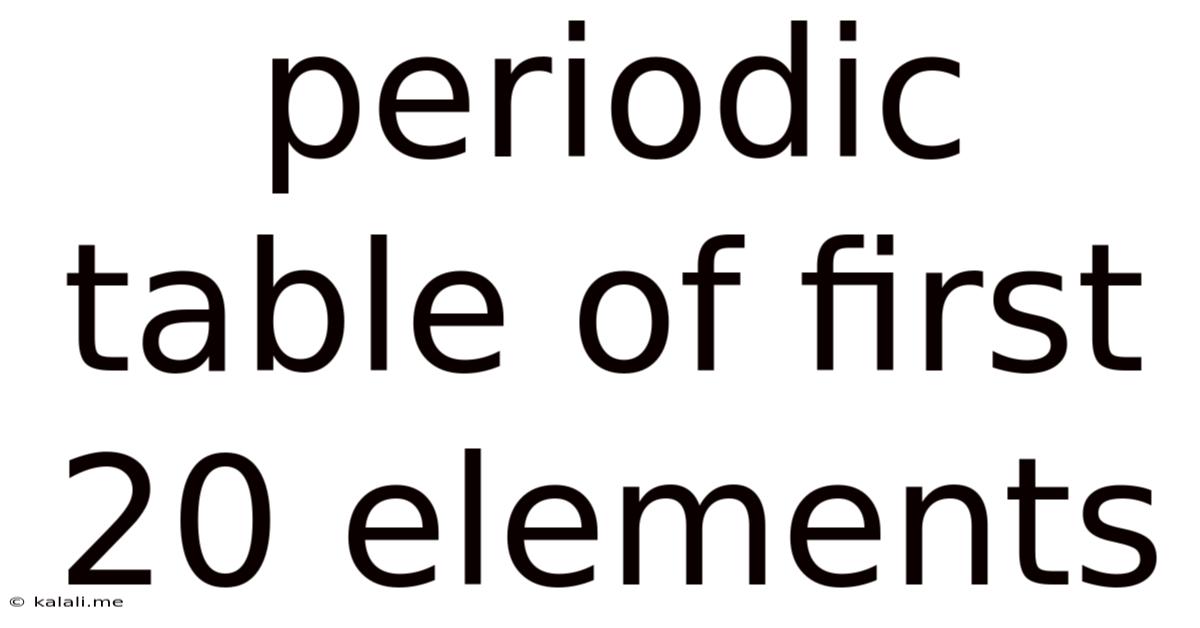Periodic Table Of First 20 Elements
Kalali
Jun 11, 2025 · 3 min read

Table of Contents
Exploring the First 20 Elements of the Periodic Table
The periodic table, a cornerstone of chemistry, organizes elements based on their atomic number and recurring chemical properties. This article delves into the first 20 elements, exploring their characteristics, uses, and importance. Understanding these foundational elements is crucial for grasping fundamental chemical concepts and their real-world applications. This detailed guide will provide you with a comprehensive overview, perfect for students, educators, or anyone curious about the building blocks of matter.
The First 20 Elements: A Closer Look
The first 20 elements represent a diverse range of properties, from the lightest gas to reactive metals. Let's explore each period and group, highlighting key characteristics:
Period 1: Hydrogen and Helium
-
Hydrogen (H): The most abundant element in the universe, hydrogen is a colorless, odorless gas. It's crucial in many industrial processes, including ammonia production and fuel cells. Its isotope, deuterium, finds applications in nuclear fusion research.
-
Helium (He): A noble gas, helium is known for its inertness and low density, making it useful in balloons, cryogenics (extremely low temperatures), and MRI machines.
Period 2: Lithium to Neon
This period introduces a wider variety of properties, including reactive metals and non-metals.
-
Lithium (Li): An alkali metal, lithium is lightweight and highly reactive. It's used in batteries, ceramics, and lubricating greases.
-
Beryllium (Be): An alkaline earth metal, beryllium is strong and lightweight but toxic. Its applications are limited to specialized alloys and nuclear reactors.
-
Boron (B): A metalloid, boron is a semiconductor used in electronics and as a strengthening agent in materials like fiberglass.
-
Carbon (C): The backbone of organic chemistry, carbon forms the basis of all life on Earth. It exists in various allotropes (different forms) like diamond and graphite.
-
Nitrogen (N): A crucial component of the atmosphere, nitrogen is used in fertilizers and the production of ammonia.
-
Oxygen (O): Essential for respiration, oxygen is a highly reactive gas vital for combustion and numerous industrial processes.
-
Fluorine (F): The most reactive non-metal, fluorine is highly corrosive and used in various industrial applications, notably in the production of fluorocarbons (e.g., Teflon).
-
Neon (Ne): A noble gas, neon is well known for its use in vibrant, reddish-orange signage.
Period 3: Sodium to Argon
This period continues the trend of increasing atomic number and varying properties.
-
Sodium (Na): An alkali metal, sodium is highly reactive and found in common table salt (sodium chloride).
-
Magnesium (Mg): An alkaline earth metal, magnesium is a lightweight metal used in alloys, fireworks, and as a dietary supplement.
-
Aluminum (Al): A highly abundant metal, aluminum is known for its lightweight, corrosion resistance, and use in packaging, transportation, and construction.
-
Silicon (Si): A metalloid, silicon is crucial in semiconductor technology, forming the basis of computer chips and solar cells.
-
Phosphorus (P): A non-metal, phosphorus is found in fertilizers and various biological molecules.
-
Sulfur (S): A non-metal, sulfur is found in various compounds and is used in the production of sulfuric acid.
-
Chlorine (Cl): A highly reactive non-metal, chlorine is a potent disinfectant used in water purification and as a component in various chemicals.
-
Argon (Ar): A noble gas, argon is used as an inert atmosphere in welding and in incandescent light bulbs.
Period 4: Potassium to Calcium (Partial)
This period begins with Potassium and Calcium, both highly important elements.
-
Potassium (K): An alkali metal, potassium is essential for plant growth and animal physiology.
-
Calcium (Ca): An alkaline earth metal, calcium is crucial for bone health and is used in various construction materials.
Importance and Applications
The first 20 elements are fundamental to life, industry, and technology. Their properties and reactivity dictate their various applications, spanning from everyday uses to advanced technological processes. Understanding their unique characteristics is vital for advancing scientific knowledge and technological development.
This exploration of the first 20 elements provides a solid foundation for understanding the broader periodic table and the incredible diversity of chemical elements that make up our world. Further exploration into their individual properties and interactions will unlock even deeper insights into the world of chemistry.
Latest Posts
Latest Posts
-
How Long Ago Was The 16th Century
Jul 01, 2025
-
How Many Inches Are In 4 Yards
Jul 01, 2025
-
How Many Calories In A Pound Of Hamburger
Jul 01, 2025
-
How Many Ounces Are In 9 Pounds
Jul 01, 2025
-
What Kind Of Room Has No Doors Or Windows
Jul 01, 2025
Related Post
Thank you for visiting our website which covers about Periodic Table Of First 20 Elements . We hope the information provided has been useful to you. Feel free to contact us if you have any questions or need further assistance. See you next time and don't miss to bookmark.